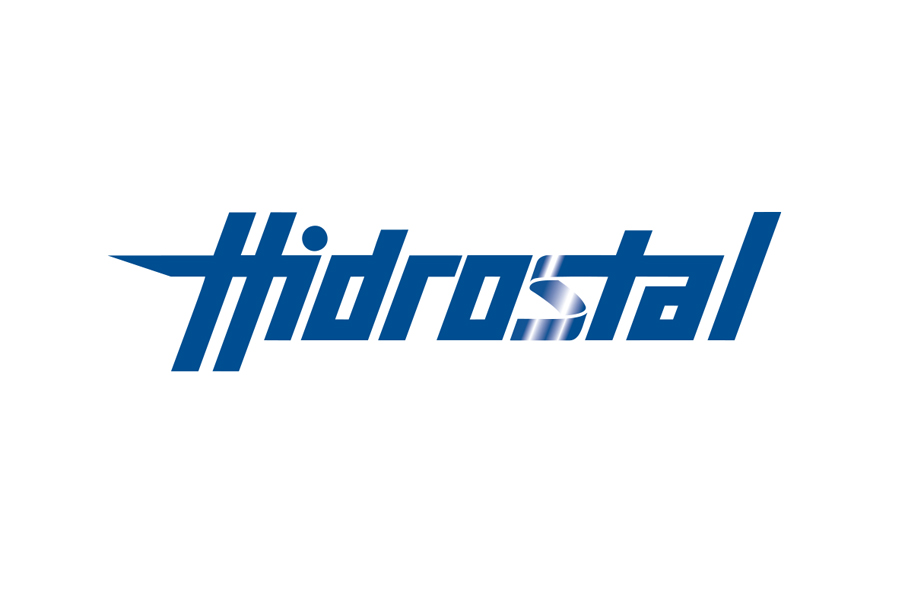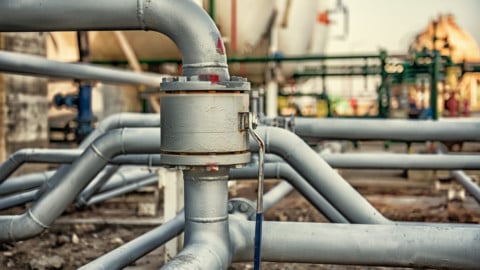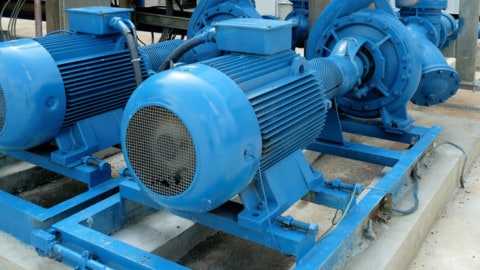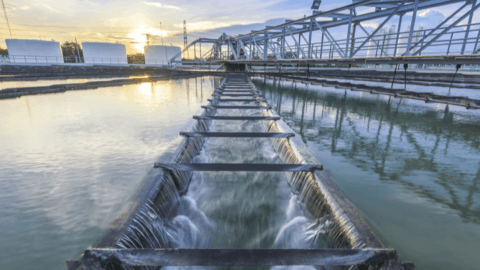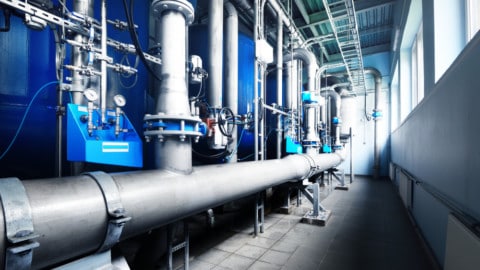Lake Gkula, located at Woodford Folk Festival in Queensland’s Moreton Bay Hinterland, is Australia’s largest conservation and recreation lake, and relies on a series of pumps to keep the water constantly flowing through its wetland filtration system, and to ensure the safety of its biodiversity and for swimmers. We sat down with the lake’s designer Patrick Handley, CEO at Waterscapes Australia, to find out more about how the system works, the equipment and the construction process.

Patrick Handley, CEO, Waterscapes Australia
Officially opened last December, the lake cost around $2.6 million to build with all the water sourced onsite from dams.
It features waterfalls, a 90m-long beach along one bank as well as a second smaller beach, an island and plenty of large rocks.
It is a chemical free lake, using all-natural systems to guarantee safe water quality with an abundant fish and plant life, including 18 species of native, freshwater fish and 9,000 endemic aquatic plants in and around the facility so far.
At over 12 million litres capacity and taking up an acre and a quarter, Lake Gkula was designed and built as an aquatic ecosystem where people can swim, snorkel, learn about and appreciate local fish and plant species.
The lake honours the region’s traditional owners, the Jinibara people, naming it after one of their principal spokespersons, Uncle Noel Blair, a much-loved and influential figure in the Woodfordian community Noel’s Indigenous name is Gkula which, translated, means Koala.
Getting the design brief
Waterscapes Australia was contracted to design and construct Lake Gkula, including the pumping and filtration systems.
Mr Handley said the design stage took about a year, with discussions starting in 2018 about what Woodfordia wanted to achieve. Woodford Folk Festival’s founder and director, Bill Hauritz, was very clear and incredibly visionary in the instigation of this project and what was to be achieved.
“The design brief was that it needed to be large enough to allow 400-500 people to swim at one time, while also being a natural ecosystem, to fit into Woodfordia’s philosophy that supports the local ecology and the culture of the festival.
It also needed to be able to be used all year round to offer more options for functions and income during the year,” Mr Handley said.
“This is the biggest system I’ve designed and constructed, and it’s actually the largest Aquascape naturally filtered, purpose-built swimming lake in the world.”

Keeping the water flowing
Key to the design of the lake was a circulation system to keep the water moving and flowing through the lake and filtration systems. High circulation, such as is found in healthy rivers and streams, is key to designing and maintaining a healthy body of water with the intended use and patronage in mind.
“The system needed to be able to move water out of the beach areas quickly and to the pump intake or skimmer bay area. That was achieved through well-designed circulation jetting placement along those beaches and lake edges,” Mr Handley said.
The system is designed so that pumps draw water into a specifically placed intake bay where floating debris is collected and removed, thereby reducing the accumulation of organic material and nutrient loads in the lake system.
Pumping 1,000,000 litres of water per hour, the lake turns over its volume every 12 hours.
There are four external pumps maintaining the necessary circulation. Two 300,000L/hr pumps supply two Aquascape upflow wetland filters before spilling back into the lake over several waterfalls.
The beach and edge circulation system is powered by two 200,000L/hr pumps with 16 jets positioned around the lake to increase movement and circulation back to the skimmer bay.
“The wetland filters are designed as massive surface areas that support massive beneficial bacteria and micro and macro organisms. We have calculations for those as to how much water we need to be able to move through them per minute per square meter.
That is in relation to the body or surface area of the whole system as well,” Mr Handley said.
“For smaller systems such as recreation ponds we use bigger filters in relation to the water body to be filtered, generally between 20-35 per cent of the surface area.
On larger bodies of water we are able to design smaller filters as the entire lake floor is covered in pebble which provides massive additional habitat for beneficial bacteria. In this case, the filters are 12 per cent of the lake’s surface area.
“The wetland filters are upflow filters – they’re high flow aerobic filters with massive surface area for beneficial bacteria, and micro and macro organisms that filter the water and compete with pathogens.”
Selecting a filtration system
Mr Handley said the filtration system design and the equipment used in the project is fairly new to Australia, although developed and used successfully for many years now in the United States and commercial projects around the world.
“We use the Aquascape Inc Upflow Wetland Filter supplied by Aquascape Supplies Australia. This system uses a snorkel and centipede system with a matrix which creates a void under the filter substrate where the water slows down, eddies, drops its silt load and then moves up through the different layers of substrate or river pebble. There are three specifically graded layers of river pebble,” Mr Handley said.

“The design minimises the chance of ‘chimneying’ of the water through the pebble and maintains the filters aerobic condition. We want that water to move laminar around those materials to maintain maximum contact with the biofilms and beneficial bacteria and organisms that form it.
That’s where the filtration happens. The snorkel allows access to the floor of the filter to carry out future maintenance such as backflushing.”
The filtration system also uses a microbubble system that produces a bubble which is about 40 microns.
“It uses atmospheric, compressed air and a micro diffuser to infuse the body of water with a very small air bubble that doesn’t float,” Mr Handley said.
“A 40 micron bubble does not have enough surface area to be fully buoyant and stays suspended in the actual water column. This saturates right down to the deepest point.
So it’ll go under the pebble, down into any detritus at the bottom and create aerobic conditions where it speeds up decomposition. This system will actually reduce accumulated organic load build up in lakes and retention ponds.
“We have installed probes in the filters and key areas of the lake and over the festival period of late January we were recording between 27.5° and 29.3°C water temperature, and we had between 93 and 100 per cent oxygen saturation.
“This is an incredible result. It meant that the system had plenty of oxygen availability to support very large populations of aerobic bacteria. So there’s really good processing of waste material going on there.”
Procuring the pumps
The pumping system comprises two wetland filter pumps that run 24/7 and two relatively smaller pumps to circulate the warmer water out of the shallower areas to reduce ‘hot spots’ that would promote algae growth, and to move water from the swimming zones.
The small pumps are on timers but run 24/7 when there are higher swimmer loads such as during festivals when lots of people are using the lake.
The pumps and plumbing all used 200-225mm PVC pipe which then split off to a three inch or 80mm flexible PVC pipe into the jetting areas and the bottom of the wetlands.
“The pumps were supplied by Grundfos through Reece Irrigation. We specified the flows we needed. Because these filters are aerobic – and we aim to create mesotrophic or oligotrophic conditions, which is low nutrient, high oxygen – we want a good flow through these filters to provide oxygen to the wetland,” Mr Handley said.

As well as meeting the required flow rates, the pumps also needed to be energy efficient and run at the lowest kilowatt possible as the they need to run 24/7 and low power consumption and energy costs for Woodfordia was important.
The two larger pumps are 7.5kW each and the small pumps are both 5kW units, with the system running about 25kW per hour when in 24/7 festival operation. The kilowatt usage will reduce during winter and low use times when the circulation pumps are running on a pumping schedule during daylight hours only.
The system is currently partially supplied by solar system, with Woodfordia working towards the whole lake’s electrical consumption to be 100 per cent renewable in the future.
Maintaining the system and the lake
Mr Handley said the system is relatively simple to maintain and doesn’t take a lot of input as no chemicals are used.
“In high load times, we may add additional beneficial bacteria cultures to maximise the biologic process and make sure there’s good populations of beneficial bacteria throughout, especially in those wetland filters.
“Six months from construction we will conduct a backflush of the wetland filters to remove accumulated sediment introduced during the construction. The wetland filters are designed so that the sediment settles in chambers under the filtration material. This slurry is pumped out during the backflush procedure.
“We then recommend a backflush every two to three years, depending on sediment loads and organic material loads.
“Over time, as the majority of the sediment is processed and removed, the backflush intervals are increased. These systems thrive and become better the more they are used, the more they are stirred up by swimming and other activities.
“Ongoing maintenance includes pruning back aquatic plants, making sure the fish populations are healthy and recommended maintenance service on the pumps. The microbubble unit has a 500 hour service as well.”
Constructing the lake
Constructing such a large lake was a big task that came with challenges that needed to be considered and overcome.
Mr Handley said bulk moving works took three weeks using a 40 tonne excavator, D9 dozer and body trucks to move the excavated material. All the excavated material was utilised on the Woodford Festival site so the bulking out logistics were fairly simple.
Shaping the lake, installation of the geotextile and Firestone EPDM liner, and rock placement including waterfall construction then took a further four and a half months to complete.
“We had two to three crews at a time working on the project, each comprising of trained Aquascape contractors who came from all over Australia to work on the build. These guys are all very talented water feature designers and builders and put their hearts into the aesthetics within my design.
The fantastic outcome could not have been achieved without their construction experience and input. Machinery-wise we utilised a 30 tonne and a 14 tonne excavator. We had a nine tonne site loader, a couple of big Posi-Track Loaders, and some small excavators as well for channel trenching,” Mr Handley said.
“Lake Gkula is over five and a half metres at the deepest point, and it’s carved out in terraces. We placed rocks on every terrace wall to create habitat and cover the lining membrane. There’s a whole technique to shaping these systems prior to lining, so we can build structurally and aesthetically.
“The liner was also a challenge. The liner used is a Firestone EPDM rubber and transporting and maneuvering the panels limits the panel size used. With 9,600m2 of liner required, the team we had to bring in and roll them into place – each 15mx60m panel weighed a tonne – and we cold-seamed them in-situ. EPDM does not require a heat seam or join.
We learned a lot of valuable techniques on how to do this on a large-scale project, you’re not dealing with straight seaming lines, there are lots of curves and liner bunching that has to be worked with.
The team had to come up with some pretty creative processes to be able to seam onsite with the help of a Firestone trained technician from Aquascape Supplies Australia.”
Logistics was another challenge to get the amount of construction rock and materials required.
Mr Handley said 2,000 tonnes of granite boulder and 1,800 tonnes of river pebble was sourced from local suppliers. Specific ratios of boulder size are used in these types of designs, rock ranging in diameter from 200mm to 1.5m was supplied by Gympie Granite. The pebble for the filters was triple washed to reduce sediment. Additionally 1,600 tonnes of triple-washed river sand was locally supplied.
“As for all of our projects, we use materials from local suppliers and had no issues getting the supply of material so the project could move along.
“A 50 tonne crane was contracted to place the majority of the boulder into place. We had to consider how we would place the rock onto the membrane of the lake which is almost 100m long, by about 70m wide. In our process, and from many years of experience, we have developed a rigging method that allows us to place each rock exactly how we want it. This is how we achieve the aesthetics in our designs.”
Mr Handley said Woodfordia wanted it to be natural and pleasing to the eye, as if you were going to the local creek, so aesthetics was key when it came to constructing the lake.
“Aesthetics and functionality is a fine line but essential in creating a living aquatic ecology that we are drawn to interact with.”

Putting the system to the test
The 2019 Woodford Folk Festival took place not long after the lake’s opening and put the lake and its pumping and filtration systems to the test with about 20,000 people using the lake over the course of six days.
Mr Handley said despite being put into use so soon after commissioning, the water quality and chemical results were fantastic, with the lake behaving as designed.
“The lake was operational for only 2.5 months prior to the festival and the ecology was still very young, the wetland filters and overall system can take 12 months to fully mature,” Mr Handley said.
“We tested the water quality four times a day for dissolved oxygen levels, and microbiological and water chemistry as well for the obvious things. Plating for fecal colonies was conducted onsite so we had almost immediate feedback on the lake’s water quality.
At one point during the festival, 550 swimmers were recorded in the water at one time and we wanted to know the conditions were good. There were no cyanobacteria or other pathogens sometimes associated with recreational waters. It stayed well within the parameters for safe recreational waters, as per Australian standards.”
An developing ecology to be experienced in the future
Mr Handley said the system as a whole, the ecology, is still maturing and the team will continue to introduce endemic fish and plant species to create a strong resilient aquatic ecosystem.
“Strong breeding populations such as Agassiz’s perchlet, South East Queensland Rainbow and Blue-eyes are already well established. Eelgrass beds and native water lilies are also establishing strongly in the lake’s habitat zones.
In time, Mary River Cod, Lung Fish and Bass will be introduced as the apex species. How epic will that be, being able to snorkel and view such fish in a natural habitat?”




